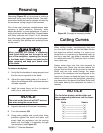
G0636X 17" Ultimate Bandsaw
-35-
Figure 48. Raker, Skip & Hook tooth styles.
Raker
Skip
Hook
• Straight Cutting: Use the largest width
blade that you own. Narrow blades can cut
tight curves (a small radius) but are not very
good at cutting straight lines because they
naturally wander (blade lead). However, larg
-
er blades are much better at cutting straight
lines, but function poorly at cutting small
curves because of their size.
Tooth Style
When selecting blades, another option to con-
sider is the shape, gullet size, teeth set and teeth
angle—otherwise known as “Tooth Style."
Figure
48 shows the three main categories of tooth
style:
• Hook: The teeth on this style have a posi-
tive angle (downward) which makes them
dig into the material, and the gullets are usu
-
ally rounded for easier waste removal. These
blades are excellent for the tough demands
of resawing and ripping thick material.
Tooth Pitch
Usually measured as TPI (teeth per inch), tooth
pitch determines the size of the teeth. More teeth
per inch (fine pitch) will cut slower, but smoother;
while fewer teeth per inch (coarse pitch) will cut
rougher, but faster. As a general rule, choose
blades that will have at least three teeth in the
material at all times. Use fine pitched blades on
harder woods and coarse pitched blades on softer
woods.
Blade Care
A bandsaw blade is a delicate piece of steel that
is subjected to tremendous strain. You can obtain
longer use from a bandsaw blade if you give it fair
treatment and always use the appropriate feed
rate for your operation.
Be sure to select blades with the proper width,
style, and pitch for each application. The wrong
choice of blades will often produce unnecessary
heat which will shorten the life of your blade.
A clean blade will perform much better than a dirty
blade. Dirty or gummed up blades pass through
the cutting material with much more resistance
than clean blades. This extra resistance also
causes unnecessary heat.
Blade Breakage
Many conditions may cause a bandsaw blade to
break. Blade breakage is unavoidable, in some
cases, since it is the natural result of the peculiar
stresses that bandsaw blades are subjected to.
Blade breakage is also due to avoidable circum
-
stances. Avoidable breakage is most often the
result of poor care or judgement on the part of the
operator when mounting or adjusting the blade or
support guides.
•
Raker: This style is considered to be the
standard because the tooth size and shape
are the same as the tooth gullet. The teeth
on raker blades usually are very numerous,
have no angle, and produce cuts by scrap
-
ing the material; these characteristics result
in very smooth cuts, but do not cut fast and
generate more heat while cutting.
• Skip: This style is similar to a raker blade
that is missing every other tooth. Because
of the design, skip toothed blades have a
much larger gullet than raker blades, and
therefore, cut faster and generate more heat.
However, these blades also leave a rougher
cut than raker blades.


















